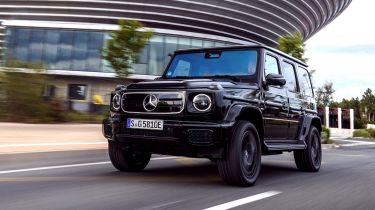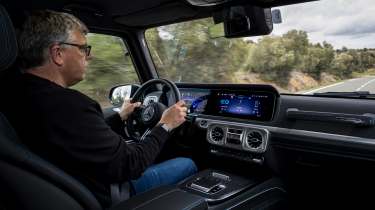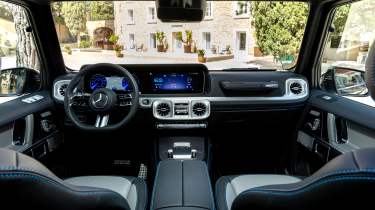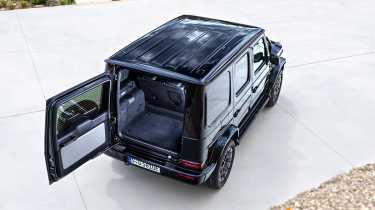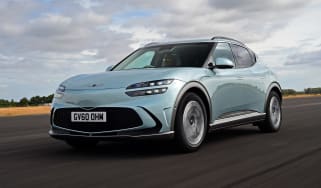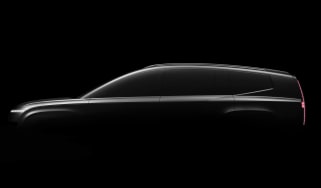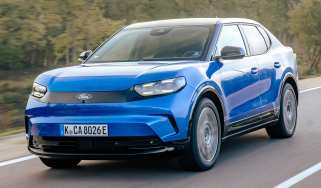Mercedes G-Class review - iconic 4x4 adds EV power
"The Mercedes G-Class isn’t a sensible choice, but it is a luxurious, fast and fun SUV that’ll turn heads like few other cars and now gets a zero-emissions option"
Pros
- A motoring icon
- Huge performance
- Impressive interior
Cons
- Running costs
- Divisive image
- Wind noise at speed
Verdict – Is the Mercedes G-Class a good car?
The Mercedes G-Class can’t really be viewed like most other cars, because boxy 4x4 rivals like the Land Rover Defender have long since been replaced with radically re-designed new models. This hardcore 4x4 appeals thanks to its striking image, and the fact Mercedes has committed to upgrading it in a way that remains faithful to the original G-Wagen, but won’t appeal to everyone. It’s expensive, powerful and luxurious, and in petrol form it costs an arm and a leg to run. For 2024 it also gained an electric version that’s smoother and even better off-road. Compromises remain, of course, including a somewhat unsettled ride and poor manoeuvrability for town driving.
Mercedes G-Class models, specs and alternatives
The Mercedes G-Wagen – referred to as the G-Class in UK showrooms – has experienced a meteoric rise in status over the years. Originally offered in the early 1980s as a simple, robust all-terrain workhorse in the vein of the Land Rover Defender, it disappeared from the UK for several years, only to resurface as a must-have accessory for wealthy urbanites.
The G-Class is now frequently seen in music videos and can be found in the car parks of Premiership football club training grounds up and down the country. With its angular, military looks (the G-Wagen has been used by numerous European armed forces), it's instantly recognisable and has a street presence that other SUVs struggle to match.
More reviews
Today's G-Class is the latest evolution of the model's most comprehensive redesign yet – all the body panels were completely replaced when it arrived in 2018, although you'd be hard-pressed to notice that at first or even third glance. With new bodywork and a redesigned chassis, the second-generation car is 53mm longer and 121mm wider, so it isn't quite as long as a Range Rover, but stands very tall and has none of the graceful curvature of the big British SUV. Elegance isn't what the G-Class is about.
Its iconic, utilitarian form – originally designed for simplicity and practicality – just happens to turn heads like nothing else, and that has become the G's greatest talent. And, while the previous model was rather compromised by its ancient underpinnings, the latest generation is a far more competent, comfortable and enjoyable machine to drive.
The G-Class received another load of updates for 2024, but as you may have guessed, you’ll need to be a G-Class aficionado to spot them. The grille gets four louvres instead of three, for instance, and there are ‘squircle’ shapes in the lower bumpers and some extra cladding around the windscreen which slightly reduces drag.
First offered only in wonderfully unsubtle Mercedes-AMG G 63 form, with a 569bhp twin-turbocharged V8 engine and acceleration worthy of a sports car, the latest G-Class is now available in diesel G 450 d form too, and for 2024 the G 63 gets mild-hybrid tech for a power bump to 577bhp.
The big news in 2024, though, was the introduction of the all-electric G 580 with EQ Technology, giving the G-Class eco credentials to go with its unstoppable power. With 579bhp it’s even more potent than the G 63, although it does have a 116kWh battery to lug around to provide its 285-mile range.
The G 400 d was fitted with a straight-six diesel engine; the same one as you'll find in a Mercedes S-Class, and it was replaced by a G 450 d for 2024. While the exuberant petrol model rivals the Bentley Bentayga for power, prestige and performance, the more low-key diesel is a far more accomplished all-rounder, that arguably suits the G-Class even better.
However, while eminently more sensible than the AMG, the G 450 d remains a car that will be bought for its charm and status rather than genuine competence. Hampered by a bluff, bulky body that does nothing for fuel economy or high-speed refinement, a Range Rover is objectively superior when it comes to interior space, handling, economy and performance, even if it doesn't feel anything like as special as the G-Class.
And that's what really matters. Where the G-Class really stands out is as a status symbol. It marks you out as someone who can buy the car for its image alone. It's a car you buy on impulse, rather than by comparing it in detail to its many expensive rivals.
MPG, running costs & CO2
The 2018 redesign included cutting the weight of the G-Class but that doesn't mean it'll start earning environmental awards any time soon – at least not with a combustion engine under its bonnet. Even the 'sensible' G 450 d diesel can only manage up to 31.7mpg, however, this is an improvement on the old G 400 d which returned 25.7mpg while emitting 288g/km of CO2. The upgrade came courtesy of new mild-hybrid tech, giving the engine a boost of up to 20bhp using energy harnessed under deceleration.
Pick its petrol equivalent in the G 500 and it can manage 25mpg, while the powerful AMG G 63 claims to manage just 19.1mpg while producing a huge 338g/km. With a twin-turbocharged V8 engine churning out 577bhp, along with the SUV's weight and bluff nose, you can expect figures in the early teens if you drive the G 63 with any gusto.
For the first time in the G-Class’ long history, it’s now also offered with an all-electric option. Badged G 580 with EQ Technology, the electric G has a sizeable 116kWh battery. It needs it, because despite its capacity, the G-Class’s sheer heft and boxy shape means it can still only muster 285 miles between charges. During brisk driving, we saw its efficiency drop to 1.4 miles/kWh, which would equate to just 160 miles from a fully charged battery.
Charging at 200kW using a DC charging station can provide a 10-80% top-up in 32 minutes, but even an 11kW home wallbox will take almost 12 hours to fully charge its battery from empty.
Expect other running costs to be fearsome, too. The G-Class' tyres are huge and will wear quickly if you frequently exercise all the G 63's power, while the same can be said for the brakes. Regular servicing is likely to be one of the more predictable costs associated with running a G-Class: Mercedes offers contracts that make it simple to stay on top of things.
On the plus side, though, the G-Class is quite sought-after secondhand, so finding a new home for yours without losing your shirt should be easy when it comes time to part company.
Engines, drive & performance
When driven enthusiastically, the previous G-Class was in constant battle with the laws of physics. While the lighter, leaner latest model is still engaged in something of a tussle, it’s now surprisingly agile and the steering is much more responsive than before.
The weight loss of combustion-engined versions hasn't turned the G-Class into a lithe, responsive sports car, but the redesigned chassis is more adept at keeping the bulky SUV under control. The steering can feel inert and disconnected but is a big improvement on that of the previous version and makes it surprisingly easy to pick a line through corners. The fact the steering has some weight to it also helps keep the G-Class stable at higher speeds.
Technology behind the scenes works hard to keep the G-Class on an even keel when you corner quickly – body lean is remarkably well contained. You still have to rely on your view of the road ahead, rather than feel through the steering and chassis, to provide you with confidence in really exploring the SUV's limits, but powerful brakes are on hand to rein in the G-Class.
It’s a shame the most impressive AMG Active Ride Control suspension is limited to the G 63, because it makes a big difference. Using hydraulic instead of mechanical anti-roll bars, it cuts body lean even further and gives the G 63 a much more fluid feel. That's fortunate, because – with 576bhp from a 4.0-litre, twin-turbocharged petrol engine also used in the Mercedes-AMG GT – the 2.5-tonne G 63 can gather momentum extraordinarily quickly. Going from 0-62mph takes 4.4 seconds, accompanied by a thundering soundtrack courtesy of side-exit exhausts. They make for a car that's louder than any other current Mercedes-AMG – another weapon in its head-turning arsenal.
The electric G 580 is technically even more potent, with 579bhp, but it also weighs well over three tonnes, which explains its 4.7-second 0-62mph time being fractionally slower. It feels remarkably similar to petrol versions on the road, and its brakes do an impressive job of slowing down its mass. We also didn’t mind its artificial ‘G-Roar’ soundtrack as you drive, which is inspired by the V8 version and never felt particularly annoying.
When we tested the G 400 d diesel, we found it far less raucous, with a smooth, cultured purr from the exhausts in place of the AMG's V8 howl. Of course, it's nowhere near as powerful, but 322bhp is still enough for 0-62mph in 6.4 seconds, which is pretty impressive for such an enormous SUV. While we haven’t tried it yet, this has been replaced by the G 450 d for 2024, with 362bhp thanks to tweaks including mid-hybrid electrification.
A nine-speed automatic gearbox is new for the latest G-Class and it’s a slick piece of engineering that can be left to its own devices or be controlled by the driver via metal paddles behind the steering wheel.
The G-Class hasn't forgotten its off-road roots. With three locking differentials, it can wade through deeper water and clamber over bigger obstacles than its predecessor, especially when the air suspension’s ‘off-road’ mode is engaged. There's also a 'G-Mode' that engages a low ratio from a transfer box connected to the nine-speed automatic transmission, allowing the car to creep slowly but steadily up hills and over rough ground. Although the G 63 is rather road-orientated with its huge wheels and sticky tyres, it still impresses on rough terrain.
Thanks to the sheer grunt of its electric motors, the G 580 really simplified off-roading when we sampled it. In Rock mode, you just have to point it at difficult terrain and the G-Class will find its way over it as you take care of its steering. Its water-wading depth is higher, too, up by 150mm to 850mm. It also has some neat party tricks, with G-Steering using the motors to adjust torque and make the G 580 able to turn really tightly off-road, which is very useful to get around some obstacles. G-Turn takes this further by effectively turning the G-Class on the spot off-road.
Interior & comfort
When it comes to comfort, the latest G-Class does a very good job of concealing its old-fashioned separate chassis construction. Increasingly advanced suspension improves the ride, although it still isn’t on par with most luxury SUV rivals.
It's a huge step forward from the previous model, particularly at motorway speeds. Although its decidedly non-aerodynamic shape is met by a huge amount of wind resistance, the noise this creates is well insulated, and the G-Class is almost as quiet inside as a GLS.
The latest G-Class is far more user-friendly inside than its predecessors, too, thanks to its dashboard being built around a far more space-efficient architecture than before. Mercedes' newest design touches are incorporated, including the turbine-look vents and metallic climate-control switchgear of the S-Class. Interior build quality is excellent, with tactile finishes in every prominent location, and more to be found hidden away.
There's enough space for a similar dashboard-spanning touchscreen entertainment system, as seen in Mercedes' latest saloon models, and that incorporates a driver-configurable digital dashboard interface. Its software was updated in 2024, and it received Apple CarPlay/Android Auto for the first time. This facelift also saw the introduction of keyless entry and wireless smartphone charging, along with a new design of steering wheel – although it’s a shame this still has annoying touch-sensitive buttons that can easily be triggered as you drive.
The G-Class lineup starts with AMG Line Premium Plus, which gets 20-inch AMG wheels as standard, along with LED headlights, leather upholstery, a Burmester stereo and twin 12.3-inch displays for the instrument and infotainment panel. Meanwhile, the G 580 is also available from launch in Edition One trim, including black exterior trim, a Nappa leather dashboard and unique off-road driving modes.
Optional extras are numerous, allowing buyers to customise the G-Class to their hearts’ content. The 'G Manufaktur' package offers a staggering array of interior trim combinations, along with paint colours and costs around £8,000. The Night Package (£1,500) brings black alloy wheels and blacked out indicators, grille and exterior trim. A £3,500 Rear Seat Entertainment Package adds two 10-inch televisions with internet access to keep back seat passengers occupied.
Practicality & boot space
The previous G-Class was rather narrow inside, which led to it feeling a little cramped, but its 121mm increase in width means it's now far more spacious for up to five passengers. There's more leg, shoulder and elbow room inside for anyone but the centre rear-seat occupant – but they get the clearest view of the road ahead as compensation.
It's still far from limousine-like in the back, though, and no end of high-quality materials can give the G-Class the luxurious feel of a Bentley Bentayga, while it can't match a Range Rover for space to stretch out in. It does make a convincing load-lugger, though, with a 640-litre boot that expands to a van-like 2,010 litres with the rear seat folded out of use. Cargo loading is hampered by a very heavy side-hinged tailgate, however, and the G 580 gets a smaller 620 litre boot because of its higher boot floor.
It's perfectly usable for a family of four, then – perhaps five at a pinch. However, bring the G-Class into the city and you might find yourself wishing you'd chosen a smaller model. Threading between rows of parked cars is a challenge and even the elevated driving position doesn't help when you can't see each corner. Getting in and out also requires some effort because the G-Class is so high off the ground.
Three-point turns are laborious, too, owing to the G-Class' very broad turning circle. At least there’s standard Parktronic with a 360-degree camera, part of the parking package that helps assist with steering and manoeuvring when parallel parking.
With huge amounts of torque and a sturdy chassis, petrol and diesel versions of the G-Class are also adept at towing, and both the G 450 d, G 500 and G 63 can haul up to 3,500kg. Mercedes doesn’t currently publish a towing figure for the electric G 580 version.
Reliability & safety
For a long time, the Mercedes G-Class has been the unofficial flagship of the brand. Although the S-Class tops the saloon-car range and the Mercedes-AMG GT S is the top-rung sports car, the G-Class is something of an icon for the three-pointed star.
Its build quality lives up to this exalted position, yet harks back to a time when cars were assembled very carefully by hand, rather than with robotic precision. The materials used are first-class, too. That doesn't necessarily translate to reliability, although the G 63's V8 engine is well-proven and other systems have been used extensively in the wider Mercedes range.
Not every Mercedes customer is delighted with their car, though – the brand only made it to 25th place overall in our 2023 Driver Power owner satisfaction survey, with a significant 28% of owners reporting a fault in the first year. However, customers told us they were impressed with the interior design and boot space. The brand was marked down for poor fuel economy, high servicing prices and steep insurance costs; traits all found in the G-Class.
Euro NCAP awarded the G-Class a five-star safety rating when it put the car through its paces in early 2019. The car scored 90% in the adult occupant category and 83% for child occupant protection. Scores of 78% and 72% for the vulnerable road users and safety assist categories respectively rounded off an impressive performance by the G-Class. Safety technology including AEB, forward collision warning and lane keep assist are all included as standard.
